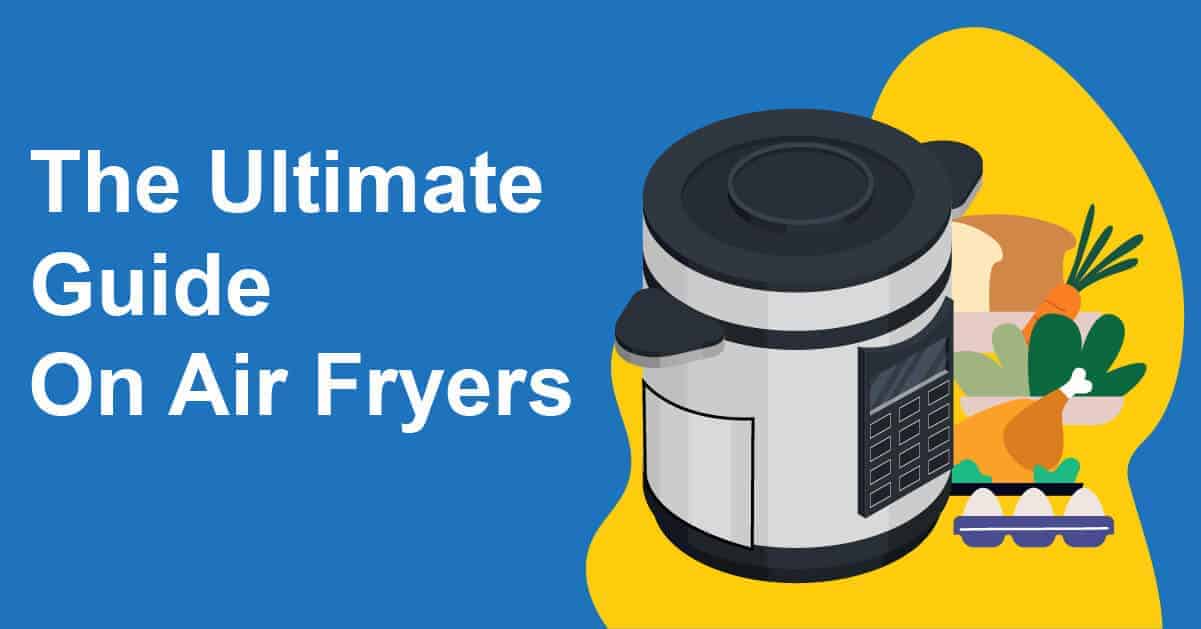
Introduction

If you find yourself frying food often, you should consider an air fryer. These handy devices are capable of cooking a lot of food without oil, making them invaluable for fast and stress-free meal preparation. Today we’re doing a deep dive into air fryers that covers the following points:
- What Is An Air Fryer?
- Healthier Than Deep Frying
- Easier To Clean
- Elements To Consider When Purchasing
Across these sections, you’ll find out what they are, how they work, why they’re healthier than other food prep methods, how to clean them, and how you can get the best models without breaking your wallet.
You’ll also find links to more information about air fryers and other devices that they are often compared with throughout this guide. This means you can learn even more about the processes that make air fryers work, so you can have more in-depth knowledge.
What Is An Air Fryer?

Before we can get into the details about air fryer cooking and maintenance, we should start by explaining what air fryers are. They have been described as convection ovens that sit on your countertop. If you’re unfamiliar with convection, here’s a video that explains how it works. All you need to know is that convection ovens use fans that circulate hot air throughout the oven space, cooking food faster and more evenly.
Air fryers also use hot air to cook, hence the name, though air frying is different from baking because the air heating is much faster. Since so much hot air is used, little to no oil is required. The top section of the air fryer is a fan and a heating mechanism that sends hot air into the compartment. The air is circled rapidly to achieve faster cooking times.
So why are air fryers getting so much attention? That’d be because their sales have rocketed over the last year. Market research group NPD has air fryer sales up by 81% compared to the previous year, probably due to the pandemic and the convenience that air fryers offer to those who cook at home.
How Are They Used?
The design of air fryers is quite uniform, so there’s a simple process to using them that can be boiled down to five steps:
- Put food into the air fryer’s compartment. Make sure it fits and will cook through properly.
- You can put 1 or 2 teaspoons of oil with the food, though this is optional.
- Set the time and temperature. The time will be between 5 and 30 minutes while the average model temperature typically lies between 350 to 400 degrees Fahrenheit (175 to 205 Celsius).
- Wait for your food to cook! Some food may need to be turned over halfway through the cooking time, especially if you want it to become crispy on both sides.
- You should clean the air fryer compartment afterward. We have more information on how to do that below.
Healthier Than Deep Frying

So, now we know what air fryers are and how they work, but what makes them better than the alternatives? Ovens and microwaves have more space than the average air fryer, so why do you need to keep an air fryer in the home?
Many advantages come with owning an air fryer. Perhaps the best and most publicized one is that air frying is healthier than deep-frying. Deep frying uses a lot of oil to cook food while air frying doesn’t, making it healthier. Of course, your general diet and what you cook in the air fryer will determine just how healthy your air-fried meals are.
Don’t Need Much Oil
Air fryers don’t need the same amount of oil as deep fryers because of their convection systems. As described above, hot air is circulated through the air fryer compartment to heat up and cook the food without requiring oil.
Deep fryers have long been the best way to cook food quickly by immersing it in burning oil. Now that air fryers have become popular, many are realizing that they require less maintenance because they don’t need oil, and that also makes them much safer. Frying has always been one of the more dangerous ways to cook, air fryers are the safest.
Only Use A Tablespoon Of Oil Instead Of A Liter
Many still advise using oil with your air fryer to get the best results. Oil helps the cooking process and so, when drizzled onto the food you’re cooking, it can make the surface crispy so it has a more pleasing texture. Even then, a tablespoon or two is more than enough to sufficiently oil up an air fryer. That’s nothing when compared to the liter that deep fryers require. If you have oil at home, it’ll last much longer when you use an air fryer instead of a deep fryer.
Absorbs Less Oil
Even when you use oil for air frying, you still use less oil and end up with a healthier meal as a result. This is because the oil is on the surface of the food which is then subject to the rushing hot air of the air fryer. This means that the oil evaporates, so while it gets the job done it uses the minimum amount of oil to do so.
The oil you use determines not just the taste of your food but also how much may evaporate during the air frying process. We’d recommend experimenting to see which oils you’d prefer, starting with:
- Almond Oil: Tastes like toasted almonds, best added during the last five minutes of cooking because it evaporates quickly. Great with vegetables.
- Avocado Oil: Great for air frying vegetables and adding a sophisticated taste to them.
- Coconut Oil: A sweet taste that works with savory dishes on occasion. It’s fatty but you’re only using tiny amounts of it anyway.
- Hazelnut Oil: Great for adding a nutty flavor to potatoes, eggplant, and rice dishes.
- Olive Oil: Olive oil is one of the most commonly used oils for a reason. Unfortunately, it evaporates quickly so you may need to add more than is typically advised. It’s best cooked with vegetables high in liquid content, so the juice reduces the evaporating process.
- Sesame Oil: Sesame oil isn’t a cooking oil; it’s better used for flavoring. This means you shouldn’t use more than 1 teaspoon while cooking and that’ll add a smoky taste.
- Walnut Oil: Another nutty oil that’s great with rice dishes like risottos.
Lowers Cholesterol Levels
Consuming less oil means your cholesterol levels will be lowered. With cholesterol, there is the good cholesterol called HDL and the bad cholesterol called LDL. Of course, each has its function but when we talk about high cholesterol, we’re referring to high LDL cholesterol. This is because it builds in the walls of your blood vessels, causing heart issues and increasing your risk of stroke.
Having lower cholesterol is a great way to bring your blood pressure down, avoiding the onset of type 2 diabetes in the process. As we age, our arteries naturally harden and this causes many issues related to your cardiovascular health. Maintaining low cholesterol keeps that process at bay and can even reverse it in some circumstances. That’s not to mention that high cholesterol causes arterial hardening, too.
Air fryers are much healthier for your cholesterol because you’re consuming less oil and so less harmful fats.
Promotes Weight Loss
Along with the cholesterol health benefits, using an air fryer is also an easy way to lose some weight. Whether you lose weight or not depends on your caloric intake and output, so what you eat, portion size, and how often you eat. Air fryers can reduce a person’s calorie intake by 70% to 80%.
Eating food that has been cooked with less saturated fats is better than eating foods with saturated fats. Fortunately, olive and canola oil have much less saturated fats and so are healthier and are tasty when used in an air fryer.
Cook Various Dishes
What you eat in your air fryer will determine how much mileage you get out of it. The best thing about air fryers is that they are incredibly versatile in what can be cooked in them. They’re not like a microwave, where certain foods won’t turn out well if you try cooking them. Instead, you can cook many savory and sweet foods in your air fryer as long as you cook them for the right time.
This is healthy because it allows you to enjoy a varied and balanced diet. It’s a common misconception with air frying that you can fry all the deep-fried foods, except it’s healthier. This causes some to overindulge in fried foods when using their air fryer when it can be used for many other types of cooking too.
We have more on the foods that can be cooked by air fryers below.
Able To Roast And Bake
As we covered at the start of this guide, air fryers operate by convection so they technically aren’t frying when you cook with them. The air fryer is so versatile that it’s hard to pin down, it can even roast and bake foods.
You can roast with an air fryer by adding some oil and any other seasonings on top of your chosen meat, and then cooking it through the usual process. Vegetables can be roasted too. As for baking, there are many simple recipes for baking desserts inside your air fryer, like brownies or meringues. An air fryer is even necessary for creating fluffier cake sponges or crispier crumble toppings than what you would get in a traditional oven.
Vegetables
We’ve said that vegetables can be roasted inside of your air fryer but there are many types of vegetables out there. Here’s a rundown of the vegetables that get you the best results when they are prepared in an air fryer:
- Asparagus
- Avocados
- Brussel Sprouts
- Carrots
- Cauliflower
- Chickpeas
- Eggplant
- Green Beans
- Onion
- Peppers
- Pickles
- Potatoes
- Pumpkin
- Radishes
- Sweet Potatoes
- Zucchini
There’s a lot that can probably work in an air fryer given the right preparation and temperature settings. Making vegetables more palatable by air frying them is a great way to please a fussy eater in the home.
There are some general rules you should follow. First, know that most greens will wilt and degrade in the extreme heat, so stick to asparagus, Brussel sprouts, and green beans to get your fill. Then, try to use vegetables as part of wet dishes because they can become soggy after being in the air fryer due to their high water content. That isn’t very appetizing when added to a dry dish.
Meats
Like vegetables, there are many types of meat that can be cooked using an air fryer too. Chicken, beef, and pork can be easily cooked inside an air fryer, no matter if they’re breaded or contain bones. The only thing that changes is the temperature and cooking duration to make sure it cooks properly. If it’ll fit in the basket compartment, it’ll probably cook without incident.
If you’re unsure, consult any literature that came with your air fryer. That should tell you if certain foods cannot be loaded into it, along with other caveats that you need to know.
Fish
Just like meat, you can cook fish inside an air fryer. You can cook standard fish filets or ones that are wrapped in batter or breadcrumbs, not to mention small bites or fish fingers, and all of those dishes can be as sophisticated or as simple as you want. For example, you can add seasonings and spritzes of oil and beer to create your own beer-battered fish.
The aggressive heating action of air fryers is actually perfect for many types of fish. With salmon, a quick way to fully heat the filet is to put it in the microwave, which cooks the meal in record time. Air fryers take this to another level by creating fast and hot rushes of air that cook unbattered fish faster than any other pan and will even crisp along the outer edges if you add oil.
Frozen Foods
Since air fryers operate like a hybrid between a convection oven and a microwave, they are great for cooking frozen foods and doing it fast. It doesn’t matter if it’s frozen vegetables, meat, or fish, often the fastest way to take some frozen food and turn it into an edible dish is to place it in the air fryer for less than half an hour, at maximum.
Once again, the magic here lies in the extra hot air that’s generated inside the air fryer by its fan and heating element. This wicks moisture away in real-time as it’s cooking. This action is so powerful that sometimes frozen food can come out slightly dry, which means you cooked it for a few minutes extra, so next time take it out for better results.
Safer Than Deep Frying
When deep-frying, or even just regular frying in an average pan, there are bubbles and spritzes of hot oil that can catch your hands or forearm when you’re adding, adjusting, or removing food. Since air fryers take the oil out of the equation, they are safer than deep frying because now you won’t catch painful, hot oil on you.
The biggest danger you face with air fryers is over-oiling the compartment basket and then getting hot residue on your arm after trying to wash the unit. That’s why you should wait for a half-hour until the unit cools down. We have a full guide on how to clean your air fryer below.
Note that air fryers that use a drawer are safer than models where you have to lift a flip-up lid and reach into the unit. That increases the risk of scraping your forearm on the hot side of the basket.
No Risk Of Splashing Or Spilling Oil
Along with the inherent safety of air fryers over other types of frying, the lack of oil is also great for hygiene and maintenance purposes. With frying and deep frying, the sizzling and shifting of the pan or the fryer will send droplets splashing over your work surface. If you neglect your kitchen work surfaces, it’ll build up into a sticky residue that will also start to smell.
If you have butterfingers and drop things often, taking oil away from the kitchen can save you valuable time that you’d otherwise have to spend mopping it off the floor. While you can use small amounts of oil for air frying, it’s a spoonful or three at most and this drastically limits your exposure to the messy substance.
Fortunately for you, you’ll learn how to clean air fryers in the next part of this guide.
Easier To Clean

Another big advantage that air fryers have over ovens is that they’re easier to clean and generally maintain. Since you need to clean a smaller compartment that is removable from the rest of the fryer, most of these trays pull out easily and can fit into the kitchen sink. This allows you to swill them out and get dish soap on every square inch of the compartment.
Air fryers are best cleaned after every use to stop the buildup of debris and fat. You can get away with one or two uses when you’re cooking dry foods but you should get into the habit of cleaning it occasionally if you want it to stay shiny.
Avoid scrubbing the compartment basket with steel wool or tough scrubbers that may take the non-stick coating off. Also keep the rest of the air fryer, where the electricals are, away from water. Sometimes food may get on the heating element, in which case you should wipe that away with a dry cloth when the fryer has cooled down.
Here’s a step by step guide on cleaning the average air fryer:
- Unplug the appliance and let it cool.
- Use non-abrasive sponge damp with hot water to clean the interior of the unit.
- Stubborn residue on the main unit can be safely wiped away with a baking soda and water scrubbing solution.
- Remove the basket and the pan that lies inside it. Place it into your sink and clean with dish soap and hot water.
- If there is an odor, you can get rid of that by rubbing lemon juice into the pan and waiting for a half-hour.
- You may need to soak them for 10 minutes if there is stubborn residue.
- Let the air fryer air dry or manually dry them with cloth, whichever you’d prefer.
If you’re using a lot of oil with your air fryer, you can also put down parchment or foil that’ll catch the liquids. Don’t cover the entire basket, however, as this will stop air from circling and interfere with the cooking process.
Not Cleaning Up Grease Or Oil
Air fryers use less oil, as we’ve covered exhaustively earlier in this guide, and that also means the air fryers are easier to clean. Air fryers aren’t just healthier, they’re easier to clean because the grease or oil that is typically used for cooking isn’t used so much. This means it doesn’t coagulate with fat and form residue on the walls of the pan. You should still clean the fryer often, of course, but know that the mess you’re cleaning would be worse if you used a deep fryer.
Some Parts Are Dishwasher Safe
If you hadn’t noticed above, we focused on hand-cleaning the air fryer. If you have a dishwasher, you can probably skip a lot of those steps by placing the basket and pan into your dishwashing machine. A normal cycle should be good enough to clean the air fryer parts sufficiently. Most air fryers can take this but not all, so you should check the leaflet that comes with your air fryer when you buy it.
Elements To Consider When Purchasing

If you found yourself here, you either own or you’re considering owning an air fryer. At this point in the guide, we have learned what air fryers are, how they work, and how they’re better than conventional fryers or ovens. Now let’s take a look at what you should consider when purchasing one. Whether you’re looking for an upgrade or we’ve convinced you to buy in, here are six things you should keep in mind when buying.
Capacity
How big do you need the air fryer to be? Air fryers come in a few sizes but most of the successful models on the market are quite small, cooking enough for only 1 or 2 people. That doesn’t stop you from cooking in rotations for larger groups but some prefer a larger fryer to get all their cooking done at once, and we don’t blame them.
The space in your kitchen is also a consideration here. Most air fryers should fit comfortably on your countertop. You can get toaster ovens with air frying modes too, though the grill inside them will be a tad trickier to clean.
Then, consider the food that you want to cook. Turning frozen fish fingers hot is one thing but you will need a larger air fryer if you want to roast a hunk of meat or make a sizable air fryer cake. The larger your air fryer is (specifically in the compartment area) the higher the maximum cooking temperature should be to cook that extra food. Many smaller air fryer models have just one temperature setting, which brings us to our next point…
Settings
Like with any appliance, you want to know the settings available before you buy. The settings tell us what the device is capable of, so you should check product listing pages for images that allow you to see them.
Pay attention to the temperature specifically. You want your air fryer to get hot enough to cook your planned meals properly, after all. To find out what temperatures you’d need, handy cooking charts can help you out.
Look through the other features and, if available, you may even find a digital copy of the instruction manual that details everything you’d want to know.
If you plan on reheating meals a lot, you can get air fryers that have a setting for that, so look out for those when searching.
Pause Features
One of the features you should definitely check out is pausing. Sometimes you need to pause cooking, often when the food inside needs to be turned over. In those cases, your air fryer may just stop when you pull out the tray and then resume when you put it back, cooking at the same temperature.
This isn’t guaranteed, however, because some air fryers reset the temperature whenever it’s interrupted. If you anticipate a lot of pausing, get an air fryer that can pause properly.
Cleaning
We’ve already covered cleaning above but what you need to keep in mind is that some air fryer models are harder to clean than others. Grills have lots of corners and right angles that can make cleaning a chore and the baskets may have divots and other textured parts to them that bite at sponges or stow residue away.
Keep cleanliness in mind when buying your air fryer. The easier the air fryer is to clean, the less time you’ll spend maintaining your purchase. We’d recommend air fryers whose components can be easily washed by the standard cycle of a dishwasher.
Loading Style
Most air fryers have a drawer that pulls out, revealing a pan and a basket in that pan to suspend food and ensure the entire thing gets blasted with hot air. Other models have flip lids that you need to reach into. Do you want to reach into a hot cauldron to fish food out? We didn’t think so, and that’s why we’d recommend the drawer air fryers because they’re much more convenient and safer.
Extra Equipment
Whether they come with the unit or as part of a bundle, there are always accessories out there that improve on kitchen appliances. Air fryers are no different. With the right additions, an air fryer can be used to bake bread or other baked sweet goods! Here is some extra equipment that can expand your cooking capabilities:
- Parchment Paper: As we covered, parchment paper is great for keeping grease off the pan. It also stops baked goods from sticking to the walls of the pan once they’re cooked.
- Baking Pan: Speaking of baking, you can get specially designed baking pans that allow you to cook all sorts of dishes. The hot air is great for cooking dense sponges and other sweet treats, especially if you get a cupcake mold to be used in the air fryer. We’d check it’s capable of hitting 400 degrees Fahrenheit before trying any serious baking.
- Pizza Pan: A simple pizza pan that’s fitted to an air fryer. You’ll need to check dimensions to make sure it fits but, if it does, you can make small personal pizzas.
- Grilling Pan: Some air fryers come with a grill already but, if they don’t, then you should buy one. Meat cooked on a grill is much crispier and it allows the fat to drip away, too. You can also grill vegetables.
- Rack & Skewers: A cooking rack elevates the food inside the air fryer, allowing more hot air to circulate and cook it. The skewers are for the readers who enjoy kebabs.
Summary

With that, you’ve reached the end of our ultimate guide to air fryers. Hopefully, you have learned a lot about these devices and how they make cooking at home much more convenient.
If you already own an air fryer, you should have a deeper understanding of how they work. If you want to get one, consider following our guide to find the best models available.
No matter which one describes your situation, your air frying skills should be taken to the next level thanks to the information in this guide.



![Should I Buy a Digital or Manual Air Fryer? [READ THIS]](https://airfryerbro.com/wp-content/uploads/2022/05/Depositphotos_378494372_L-211x150.jpg)